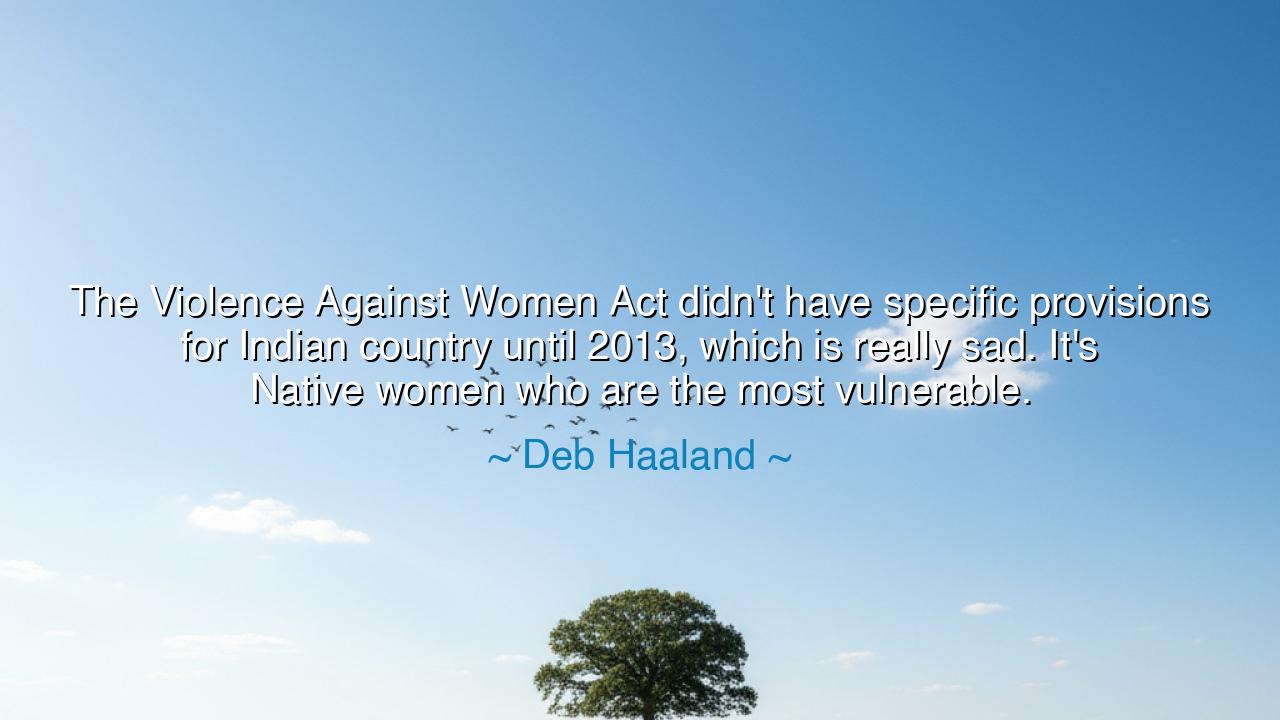
The Violence Against Women Act didn't have specific provisions
The Violence Against Women Act didn't have specific provisions for Indian country until 2013, which is really sad. It's Native women who are the most vulnerable.






There are truths so long neglected that their acknowledgment brings both sorrow and resolve. Deb Haaland, reflecting on the long struggle for justice, said, “The Violence Against Women Act didn't have specific provisions for Indian country until 2013, which is really sad. It's Native women who are the most vulnerable.” In these words, we hear not merely a statement of law, but the lament of centuries of oversight, marginalization, and suffering. Native women, who carry the weight of history upon their shoulders, have endured violence that was too often invisible to the nation’s eyes. Haaland’s words remind us that recognition and protection are acts of moral urgency, and that the absence of both perpetuates tragedy.
For decades, the Violence Against Women Act (VAWA) provided critical protections for survivors across the United States, yet its initial failure to include specific provisions for tribal lands left Native women in a precarious state. They faced crimes that often went unpunished, because jurisdictional gaps allowed perpetrators to act with impunity. This is not mere policy—it is a reflection of the ways in which history and law have often marginalized the most vulnerable, leaving them exposed to violence without remedy. The sadness Haaland evokes is rooted in this systemic neglect.
The 2013 reauthorization of VAWA was a watershed moment. For the first time, tribal authorities were empowered to prosecute non-Native perpetrators in certain cases, restoring a measure of justice to communities that had long been denied it. Yet even this progress, though vital, is not sufficient. As Haaland emphasizes, Native women remain the most vulnerable, facing rates of domestic violence and sexual assault far higher than the national average. This vulnerability is both a symptom of historical oppression and a call to ongoing action.
Throughout history, those who are most marginalized have often relied on resilience, courage, and community to survive in the face of neglect. Consider the story of Winona LaDuke, an activist and leader from the Anishinaabe nation, who has fought tirelessly for Native rights, land preservation, and community protection. Her life’s work demonstrates that while laws can lag behind justice, the determination of individuals and communities can illuminate the path forward. Like Haaland, she embodies the principle that recognition alone is insufficient; action must follow awareness.
The sadness Haaland speaks of is not passive—it is a call to responsibility. Ancient wisdom teaches that justice is inseparable from care for the vulnerable. In the societies of old, protection of women, children, and the marginalized was seen as a sacred duty, a measure of civilization itself. When the law neglects the vulnerable, it is not only an injustice to them—it is a wound to the moral fabric of the entire society. Haaland’s words echo this timeless truth: those who suffer in silence are a mirror of the society’s shortcomings.
Her statement also underscores the importance of listening to the voices of those most affected. Native women have long sounded the alarm about their communities’ needs, yet systemic barriers prevented meaningful response. In this sense, the struggle is both legal and moral: it requires laws that reflect reality, and hearts that reflect empathy and commitment. The inclusion of tribal provisions in VAWA is proof that change is possible when voices are heard, but it is also a reminder that vigilance and advocacy must continue.
From Haaland’s reflection, a profound lesson emerges: justice delayed is not justice denied, but it is fragile and incomplete. It is not enough to recognize injustice; one must act decisively to prevent it, to empower those at risk, and to mend systems that have long permitted harm. Every community bears responsibility for its most vulnerable members, and every citizen bears the duty of awareness and action.
Therefore, let us remember the wisdom in Haaland’s words: the protection of the vulnerable is not merely a legal obligation, but a moral one. Seek out the stories of those unheard, support the structures that defend them, and challenge the systems that leave them exposed. By doing so, we honor not only the victims of violence, but the enduring principle that a society is measured by how it safeguards its weakest and most at-risk members. In protecting the vulnerable, we protect the soul of the community itself.






AAdministratorAdministrator
Welcome, honored guests. Please leave a comment, we will respond soon